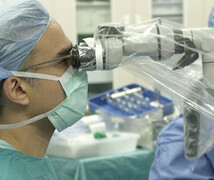If you’ve been diagnosed with essential tremor and medication is not doing enough to control your involuntary shaking, high-intensity focused ultrasound (HIFU) may be an option. This FDA-approved treatment requires no incisions and can reduce severe essential tremors by about 70%.1 Here, Duke neurosurgeon Nandan Lad, MD, shares how HIFU works and what you can expect from this treatment.
How HIFU Works
High-intensity focused ultrasound, or HIFU, relies on an MRI technique called diffusion tensor imaging to accurately target and direct sound waves to a tiny area of your brain that helps regulate movement. Like a magnifying glass concentrates sunlight, the focused ultrasound energy creates enough heat to selectively interrupt signals that cause tremors.
“When we disconnect that tremor circuit, the tremor stops,” Dr. Lad said.
Why Choose HIFU
HIFU targets the same area of the brain as other procedures like deep brain stimulation (DBS) and traditional thalamotomy surgery. However, HIFU requires no incisions, implanted probes, ionizing radiation, or general anesthesia. The risk of infection and side effects are also lower with HIFU.
“There are people who are aware of deep brain stimulation but think, ‘My tremor is not so bad that I want to have a brain surgery or wires and a pacemaker implanted inside my body,’” Dr. Lad said. HIFU is a much less invasive procedure that doesn’t require a hospital stay. “Basically, you could come in with severe tremors and see a significant improvement the same day, and that is something more and more people are interested in."
What to Expect During HIFU
Because ultrasound beams don’t penetrate through hair very well, your head will be shaved before the procedure. Then your doctor will numb four spots on your scalp where a custom frame will be fitted. The frame keeps your head perfectly still during the procedure.
Next, you’ll lie on an MRI bed wearing a helmet-like device secured to the metal frame. The bed will move in and out of the MRI scanner as it maps your unique tremor brain circuit.
Once doctors have identified a target area in your brain, they will apply a low dose of focused ultrasound energy. This is like a test run, allowing doctors to fine-tune the target. Doctors may ask you to provide feedback, like whether you feel any tingling in your fingers.
When your doctors have identified the final target area, they will apply the full dose of focused ultrasound treatment. Then your doctor will test the success of the treatment by asking you to complete a simple task, such as draw a spiral, write your name, or hold a cup.
Afterward, doctors will observe you for about an hour, remove the head frame, and make sure you’re comfortable before you go home. Many people experience some instability or what feels like “sea legs” for the first couple weeks after treatment. “That's usually from the swelling around the focused ultrasound lesion. It expands over the first several days, and then it contracts back to normal,” Dr. Lad said. Other side effects like numbness, tingling, and headaches typically resolve within a month.
Is HIFU Right for Me?
If you are an adult with refractory essential tremor (meaning medications aren’t working well enough), HIFU might be right for you. “I’m excited to offer this ‘cutting edge’ therapy that is completely incisionless. I believe this will become the dominant treatment for essential tremor over the next several years,” Dr. Lad said.




